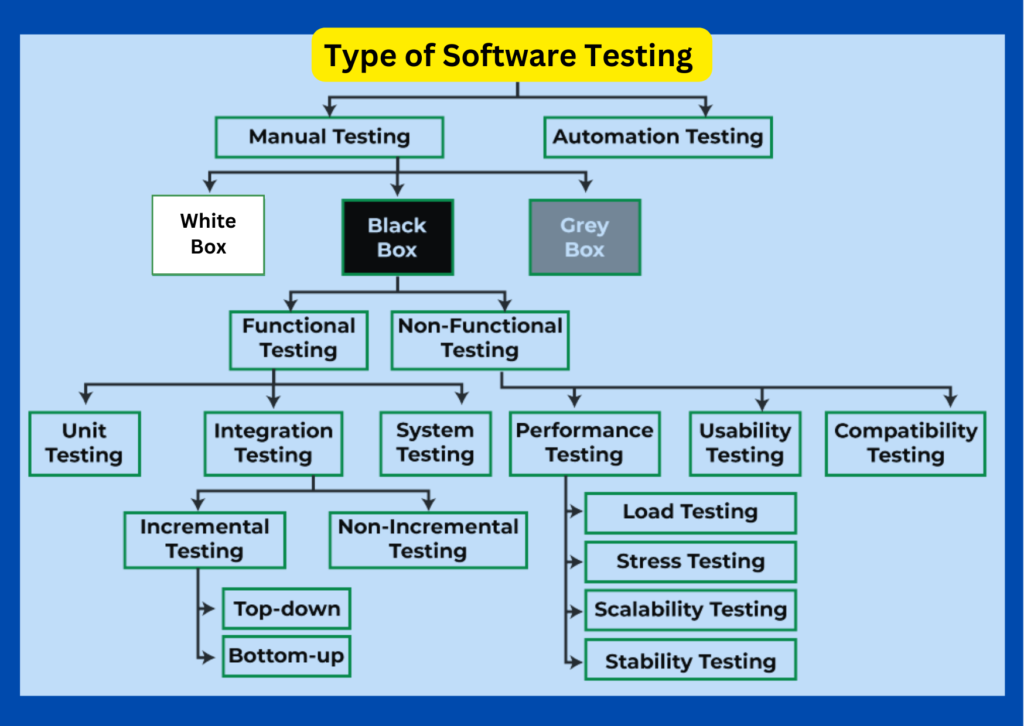Have you ever been disappointed to drive a brand-new automobile off the lot only to discover that the engine won’t start and the doors won’t open smoothly? It may be really frustrating, right? Well, just like in the world of cars, software development can also suffer from poor quality. That’s where the unsung heroes of the digital universe come in: software testers.
Introduction
The rigorous and crucial discipline of software testing is devoted to finding and fixing errors and malfunctions in software before they affect end users. It is an essential part of the software development process and serves as a quality control system for different kinds of websites, software, and applications. Software testing provides a wide range of tools, each especially made to fulfill a certain purpose, much as the automotive industry creates a variety of car models.

Software testing is important because it can reveal flaws and faults in the software, making sure that the finished result complies with end users’ needs and expectations. We will examine the various kinds of software testing in this thorough investigation, illuminating the various strategies and techniques used during this crucial stage of software development.
Software testing can be divided into two stages
Verification: Verification involves a series of tasks that guarantee the accurate implementation of a particular function in the software. It essentially asks, “Are we constructing the product correctly?”
Validation: Validation encompasses a distinct set of tasks that ensure the software aligns with the customer’s requirements. It essentially asks, “Are we constructing the correct product?”
Importance of Software Testing
- Early defect detection: Software testing is crucial because it allows for the early detection and correction of any defects before the program is released.
- Enhances software quality: Software testing finds flaws in the program, and resolving them makes the program better.
- Enhanced customer satisfaction: Software testing saves time, money, and aggravation by guaranteeing dependability, security, and peak performance.
- Promotes scalability: Non-functional software testing aids in determining scalability problems and the potential endpoint of an application’s functionality.
- Saves money and time: It will be extremely difficult to identify and fix problems once the program is launched because doing so will cost more
The Need for Software Testing
The possible implications of software bugs, which can lead to large financial losses and, in many situations, fatal human results, make software testing absolutely necessary. Past events highlight how important the testing stage is to the creation of software. Here are some noteworthy instances:
1985: A software bug caused the Therac-25 radiation therapy system in Canada to malfunction, leading to tragic consequences with three fatalities and three injuries due to excessive radiation dosages.
1994: A software glitch was responsible for the crash of a China Airlines Airbus A300, resulting in the devastating loss of 264 lives.
1996: An astounding $920 million was mistakenly credited to the accounts of 823 customers due to a software fault in a U.S. bank’s system.
1999: A software glitch caused a $1.2 billion military satellite launch to fail.
2015: The F-35 fighter plane’s ability to detect targets was compromised by a software glitch.
2015: 300,000 financial traders were impacted by a software glitch that brought down Bloomberg terminals in London, forcing the government to reschedule a £3 billion debt offering.
2020: A radiotherapy machine’s software error caused multiple cancer patients in the UK to overdose.
2021: A police car and a Tesla on autopilot collided, exposing the flaws in autonomous driving technology.
2022: Thousands of passengers’ travel plans were hampered by a major airline’s widespread software outage, which grounded hundreds of flights.
2022: Global grounding of numerous Boeing 787 Dreamliners due to a software fault that affected flight displays caused travel disruptions and cost airlines millions of dollars. This event highlights the weakness of intricate systems that depend on error-free software.
2022: Federal Aviation Administration NOTAM System Outage: A software bug rendered the Notice to Air Missions system of the Federal Aviation Administration inoperable, causing hours of flight cancellations for all domestic US flights and causing a jolt to the aviation sector. This highlights how isolated software errors can have cascading effects.
2023: Cybersecurity in 2023 Medical Device Vulnerabilities: There are terrifying worries about patient safety when vulnerabilities are discovered in insulin pumps and pacemakers. Software testing is about protecting lives, not simply making things easier.
2023: Deaths from Self-Driving Cars: Autonomous vehicles have the potential, but due to software errors, they have already been engaged in tragic accidents. These tragedies highlight how important testing is to guaranteeing the security of cutting-edge systems.
2023: Issues with Cryptocurrency Exchanges: Users of cryptocurrency exchanges lose millions of dollars as a result of outages and bugs. This emphasizes how important it is for high-stakes financial innovations to undergo thorough testing.
Beyond these well-known instances, several lesser incidences may place every day: missed work because of system failures, incorrect medical diagnoses resulting from faulty algorithms, and even interruptions to global finance. Every occurrence is a clear reminder of the basic need for software testing.
A recent example is:
Starbucks: Where more than 60% of its locations in the United States and Canada had to close due to a software malfunction in the Point of Sale (POS) system.
Nissan: A software issue with the airbag sensory detectors prompted a recall of one million vehicles.
These occurrences serve as a reminder of the continued value of software testing in averting potentially disastrous situations and in highlighting the necessity of strong quality assurance procedures in software development.
There are different types of software testing, including

Software testing can be further categorized into two distinct approaches
1. Manual Testing:
Manual testing is a method where testers assess software without the use of automation tools or scripts. Testers, essentially adopting the perspective of end-users, scrutinize the software for unexpected behavior or bugs. Unit testing, integration testing, system testing, and user acceptability testing are just a few of the phases that this method covers. To achieve thorough testing, testers rely on carefully constructed test cases, test scenarios, or test plans. Manual testing also contains exploratory testing, wherein testers delve into the software to identify any flaws.
2. Automation Testing:
Automation testing, also referred to as Test Automation, involves the creation of scripts by testers to employ additional software in testing the product. This process automates a manual testing procedure, facilitating the swift and repetitive execution of test scenarios that were originally performed manually. Automation testing extends beyond regression testing to evaluate applications from load, performance, and stress perspectives. Its advantages include increased test coverage, enhanced accuracy, and substantial time and cost savings compared to manual testing. Automation testing is particularly beneficial for re-running tests efficiently and ensuring robust testing in scenarios requiring repetitive executions.
Various software testing techniques fall into two primary categories
- Black Box Testing: This method involves evaluating the program without the tester having access to the source code. This approach disregards the core logical structure in favor of the software interface. Black-box testing involves assessing software without delving into its internal operations.
- White-Box Testing: White-box testers are familiar with the internal workings of the product and have access to its source code. This method makes sure that every internal process follows the guidelines. White-box testing necessitates knowledge of the internal logic and architecture of the software, in contrast to black-box testing.
- Grey Box Testing: Grey box testing falls between black box and white-box techniques. Testers conducting grey box testing have some knowledge of the software’s implementation but are not necessarily experts. This method leverages certain internal knowledge to enable a balanced review without necessitating in-depth expertise. The goal of grey box testing is to find a compromise between black box testing’s exterior focus and white box testing’s thorough comprehension.
Software testing encompasses three broad categories
- Functional Testing: Functional testing, which ascertains whether a software system conforms with its declared functional requirements, is a significant type of software testing. Verifying sure the application operates in accordance with the defined functional expectations is the aim of this approach. Functional testing is a process that involves multiple stages, such as Unit, Integration, System, and Smoke testing, which concentrate on distinct facets of functionality.
- Non-functional Testing: Software testing that assesses an application’s performance, scalability, portability, and stress tolerance in relation to non-functional criteria is known as non-functional testing. This kind of testing verifies that the program satisfies standards pertaining to its overall performance and user experience in addition to functional features. Performance testing, stress testing, and usability testing are examples of non-functional testing evaluations.
- Maintenance Testing: Updating, altering, and changing the program to accommodate changing user requirements is referred to as maintenance testing. Regression testing is one of its features; it verifies that recent code modifications haven’t negatively affected software components that were previously operational. To guarantee the software’s continued dependability and flexibility in response to shifting needs, maintenance testing is crucial.
Different Levels of Software Testing
- Unit testing: In the software development process, unit testing is the lowest level of testing. It entails testing separate software program modules or components.
- Integration Testing: This type of testing focuses on examining how various software program sections or components communicate with one another.
- Functional Testing: The goal of functional testing is to make sure that every software feature operates in accordance with the requirements that have been set forth.
- Acceptance Testing: This type of testing is done to make sure the program satisfies the demands and requirements of the user.
Other Type of Testings
- Regression Testing: The goal of regression testing is to find any new defects or problems that might have been brought about by changes to the program.
- Performance Testing: This kind of testing confirms how well a software program operates under various workload scenarios.
- Security Testing: Security testing evaluates the software application’s capacity to safeguard data and resources against unauthorized access or attacks.
- Usability Testing: Usability testing assesses the user-friendliness and ease of use of a software application.
- Compatibility Testing: Compatibility testing is a crucial type of testing that guarantees the proper functioning of the software application on various platforms, browsers, and devices.
- Load Testing: Load testing is a form of testing that assesses the performance of a software application in both regular and high load scenarios.
- Stress Testing: Stress testing is a form of evaluation that assesses the performance of a software application when subjected to extreme or demanding conditions, in order to ascertain its stability and resilience.
- Localization Testing: Localization testing is a crucial type of testing that guarantees the software application is well-suited and operates flawlessly in various languages, cultures, and regions.
- Installation Testing: Installation testing is a form of testing that validates the software application’s installation procedure and examines for any problems or mistakes that may occur during the installation process.
- Recovery Testing: Recovery testing assesses the software application’s capability to bounce back from failures or crashes and resume its regular operations.
- Exploratory Testing: Exploratory testing is a unique approach to testing where testers engage in simultaneous learning, test design, and test execution. This method allows them to uncover defects and gain a more profound understanding of the software application.
Benefits of Software Testing
- Quality and Stability Boost:
- Fewer Bugs: Testing ensures a glitch-free user experience, eliminating crashes and errors.
- Reduced Downtime: Minimizing system crashes enhances productivity and revenue.
- Improved Performance: Testing optimizes resource usage for faster and smoother workflows.
- User Satisfaction and Confidence:
- Intuitive Interfaces: Usability-focused testing leads to logical, user-friendly interfaces.
- Increased Accessibility: Testing caters to diverse needs, promoting inclusivity.
- Enhanced Security: Rigorous security testing fosters user trust by safeguarding data and system integrity.
- Cost-Effectiveness and Risk Mitigation:
- Early Bug Detection: Identifying and fixing bugs during development saves costs.
- Reduced Post-Release Issues: Thorough testing minimizes post-release expenses.
- Brand Reputation Protection: Testing prevents public-facing issues, safeguarding brand reputation.
- Competitive Advantage:
- Improved Differentiation: High-quality software stands out in the market.
- Faster Time to Market: Efficient testing accelerates development cycles.
- Innovation Catalyst: Testing removes roadblocks, allowing focus on cutting-edge features.
Call To Action
Software testing is not limited to tech-savvy individuals! Whether you are an aspiring entrepreneur, a curious user, or someone who values high-quality work, having a grasp of the fundamentals of software testing can give you a sense of empowerment.
Next Steps: Consider enrolling in a test-driving course, try out a testing app, or begin examining the software you use on a daily basis with a discerning eye. You might be pleasantly surprised by the bugs you come across!
Join the Community: Connect with like-minded testing enthusiasts online, share your experiences, and gain knowledge from one another. Remember, creating top-notch software is a collaborative endeavor!
Conclusion
FAQs
Q1. What is software testing?
A1. Software testing involves assessing a software application to ensure it meets the designated requirements and functions as anticipated.
Q2. Why is software testing important?
Q2. Software testing is essential for finding bugs and inconsistencies in the program and ensuring that it meets end users’ demands. Additionally, it helps to minimize the likelihood of any future software problems and improves the overall quality of the program.
Q3.What are the different types of software testing?
A3. There are several types of software testing, including: Unit testing, Integration Testing, Functional Testing, Acceptance Testing, Regression Testing, Performance Testing
Q4. What is the difference between verification and validation?
A4. Verification involves checking whether the software meets the defined requirements and functions as intended. On the other hand, validation ensures that the software fulfills the customer’s needs and is suitable for its intended purpose.
Q5. What is the difference between black-box testing and white-box testing?
A5. Black-box testing is a method of testing that checks if the software functions correctly without knowing the internal code structure, paths, or implementation details. In contrast, white-box testing involves examining the internal structure, design, data structure, code structure, and operation of the software.
Q6. What is exploratory testing?
A6. Exploratory testing is a special type of testing that brings together learning, test design, and test execution in a single process. It’s an approach that enables testers to take responsibility for their work and continuously enhance its quality. By treating test-related learning, test design, test execution, and test result interpretation as interconnected activities, exploratory testing ensures a seamless and efficient testing process throughout the entire project.
Q7.What is usability testing?
A7. Usability testing is a type of testing that evaluates how easy it is to use a software application. It involves testing the software with real users to identify any usability issues and to ensure that the software meets the needs of the end-users.
Q8.What is security testing?
A8. Security testing is an essential type of testing that ensures the safety and protection of a software application. It focuses on identifying any potential vulnerabilities or weaknesses that malicious attackers could exploit.





[…] stage involves rigorous testing of the software to identify and fix any defects. We also conduct integration testing to ensure that […]
[…] cutting down on testing time. 8. Increased Test Quality: You may access a greater variety of testing scenarios and reduce human mistake, which will raise the test quality as a […]
[…] cases run, the pass/fail status, defect metrics, and the overall test coverage is created after the testing is finished. Test reports give stakeholders important information about the software’s […]